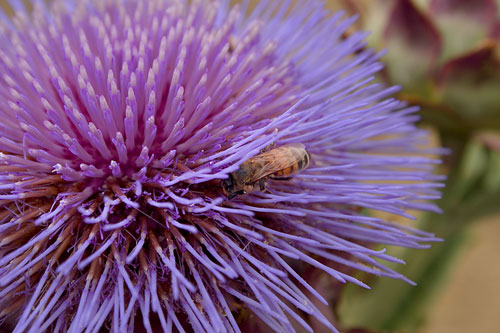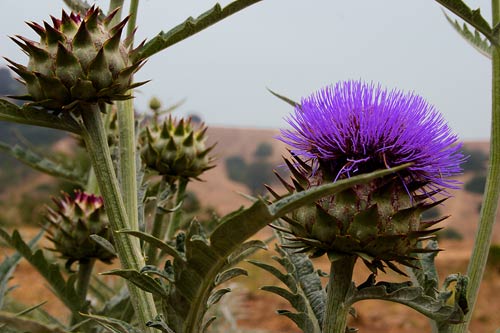 Common and Scientific Names
Common and Scientific NamesArtichoke thistle
Cynara cardunculus L.
Origin and Distribution
Artichoke thistle is a native of the Mediterranean regions and was first reported in Victoria at Williamstown in 1884. Infestations are present throughout central Victoria, extending from the Murray river at Echuca to Melbourne and westerly.
Description
Artichoke thistle is a stout, erect, greyish perennial which forms a rosette of very large leaves and usually grows to a height of 60 to 150 cm, although occasional plants are found over 2 metres high. Seeds germinate mainly in autumn and the plant usually flowers in its second summer. It grows mainly on medium to heavy soils in pastures, on roadsides and creeklands, waste lands and vacant industrial areas.
Stems - of mature plants are branched, strongly-ribbed and covered with cottony down. There is usually only one stem per plant, but may be as many as eight. The stems are produced in spring and bear flower heads at the end of each branch in summer.
Leaves - vary considerably in length; the basal leaves can be up to 1 m long and 30 cm wide, whereas the stem leaves are often only 15 cm long. The upper surface of the leaves is a greyish-green colour, while the under surface appears almost white because of a dense mat of white hairs. The leaves are much divided, each lobe ending in a sharp, yellow spine.
Flowers - blue to purple in colour, 5 to 13 cm in diameter, and surrounded by a series of stout bracts each ending with a spiny tip. Flowering occurs from December to February.
Seeds - 6 to 8mm long, brown or black in colour, and topped by a loosely attached pappus (parachute) of feathery bristles, up to 40 mm long.
Roots - large fleshy taproot, somewhat like an oversized parsnip, which may grow to a depth of 2 metres. New growth develops from the crown each year.
The Problem
Artichoke thistle has the ability to dominate the vegetation of an area once it becomes established. The large plants smother most pasture growth as well as drawing much moisture and nutrient from the soil. It may also compete with crops and impede harvesting operations. The prickly nature of the leaves deters sheep and cattle from areas of heavy infestation.
Heads from the heavy infestations around Melbourne have been collected and treated in the same way as globe artichokes (Cynara scolymus) for eating. Globe artichoke has fleshier flowers with fewer spines and has not become a weed. Hybrids of the two species have been identified in Victoria. Artichoke thistle has also been used as a cut flower for decoration.
Artichoke thistle is thought to cause contact dermatitis with some people.
Dispersal
The pappus aids the dispersal of the seed by wind, but it is not very effective because of the weight of the seed. Most seeds drop within a few metres of the parent plant as they separate from the loosely attached pappus, whilst others may blow as far as about 20 metres.
Seed is also spread by animals and birds, and by flood waters. The careless disposal of cut flowers also contributes to dispersal. Fragments of cut root will generate new plants in favorable conditions.
 Artichoke thistle
Artichoke thistle Artichoke thistle
Artichoke thistle Artichoke thistle
Artichoke thistle Artichoke thistle
Artichoke thistle Artichoke thistle
Artichoke thistle
No comments:
Post a Comment